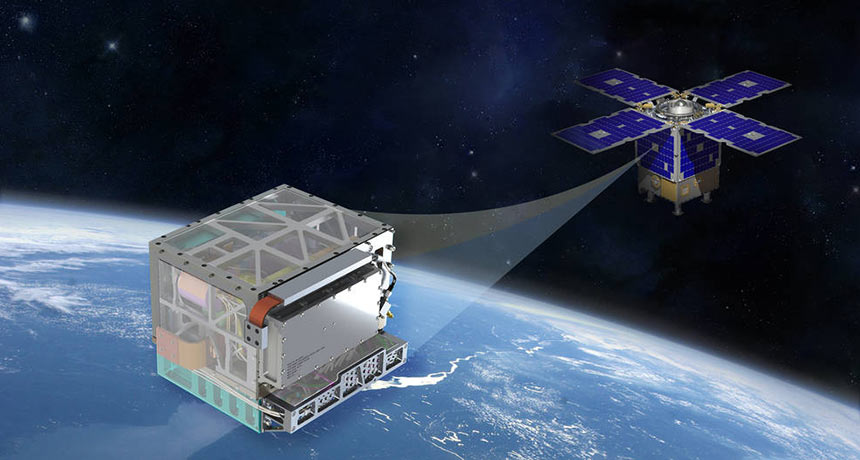
TIMING IS EVERYTHING NASA’s Deep Space Atomic Clock (illustrated with the spacecraft that will carry it) is set to launch for a yearlong test flight in low-Earth orbit. The timepiece could one day enable self-driving spacecraft and GPS-like systems on other worlds.
NASA
- More than 2 years ago
Traveling the solar system could one day be as easy as taking a bus to work. Scientists envision self-driving spaceships ferrying astronauts through deep space, and GPS-like systems guiding visitors across the terrains of other planets and moons. But for those futuristic navigation schemes, spacecraft and satellites would need to be equipped with clocks that keep time with extreme precision — more precise than any timepiece ever sent to space.
A prototype of that clock is scheduled to launch on June 24 for a test flight.
NASA’s Deep Space Atomic Clock, or DSAC for short, counts off the seconds with ticks that are about 50 times more uniform than those of atomic clocks onboard GPS satellites. That’s on par with the ground-based atomic clocks used for the agency’s Deep Space Network — the cadre of earthbound facilities that use radio antennas to communicate with missions throughout the solar system. But unlike those refrigerator-sized timepieces, the toaster-sized DSAC is small enough to carry aboard a spacecraft.
Outfitted on future spaceships or satellites, this mini atomic clock could “completely change the way we navigate spacecraft through deep space,” Jill Seubert, deputy principal investigator for the project, said June 10 in a news conference.
After the prototype launches from NASA’s Kennedy Space Center at Cape Canaveral, Fla., researchers will monitor its performance in low-Earth orbit for one year. Here’s a preview of what the clock could mean for future spacefaring.
How would the clock change space navigation?
“Every single spacecraft exploring deep space today relies on navigation that’s performed back here at Earth,” said Seubert, who’s based at NASA’s Jet Propulsion Laboratory in Pasadena, Calif. Earth-based antennas send signals to spacecraft, which the spacecraft echo back. By measuring a signal’s round-trip time within a billionth of a second, ground-based atomic clocks in the Deep Space Network help pinpoint the spacecraft’s location.
With the new Deep Space Atomic Clock, “we can transition to what we call one-way tracking,” Seubert said. A spaceship would use such a clock onboard to measure the time it takes for a tracking signal to arrive from Earth, without having to send that signal back for measurement with ground-based atomic clocks. That would allow a spacecraft to judge its own trajectory.

What are the perks of one-way tracking?
Having a spacecraft that’s able to track its location would allow astronauts to steer themselves through the solar system without needing instructions from Earth. “At a place like Mars, the round trip [tracking signal] time can range something like eight to 40 minutes,” says the project’s principal investigator Todd Ely, also based at NASA’s Jet Propulsion Lab. “At Jupiter, it can be … an hour and a half. Saturn, two and a half hours.”
With a craft enabled to track itself, explorers could execute more nimble maneuvers and react more quickly to unexpected situations. “Far term, I’m really excited about … using the clock with other navigation instruments onboard to create something like a self-driving spacecraft,” Ely says.
How would the clock enable navigation on other worlds?
“Just imagine an astronaut hiking on Mars, and maybe Olympus Mons is rising in the background, and she’s checking her Google Maps Mars Edition to see where she is,” Seubert said at the news conference. “The concept would really be the same as what we have for GPS here” on Earth, with a constellation of satellites providing global coverage to the surface.
On other worlds, satellites would use onboard Deep Space Atomic Clocks to broadcast signals with precise timestamps, which could be used by any GPS ground receiver to triangulate its position.
What makes the new space clock more reliable than others?
The new atomic clock keeps time using charged mercury atoms, or ions, whereas clocks currently aboard Earth’s GPS satellites use neutral rubidium atoms. Since the mercury atoms in the new clock have electric charge, they can be trapped in electric fields that prevent them from interacting with the walls of their container — interactions that in GPS atomic clocks cause the rubidium atoms to fall out of rhythm, Ely explains.
Earth’s GPS satellite clocks require twice-daily corrections from a command center on Earth. But the new atomic clock is far more reliable in ticking uniformly, so corrections wouldn’t be needed so frequently. “If you had the Deep Space Atomic Clock,” Ely says, “twice a day could turn into weeks, if not months.”
What will scientists test during the prototype’s first flight?
Scientists need to ensure that the steadiness of the clock’s ticking holds up in space. “Our goal is a [gain or loss of time] of about two nanoseconds or less per day,” Ely says. “We think we’re going to get close to about three-tenths of a nanosecond per day.”
This dress rehearsal spaceflight will also test how the clock fares for an entire year in space. “This will tell us a lot about how we can operate these clocks for much longer time periods when they’re traveling to places that might take months or years or even a decade to get to,” Seubert said. Researchers expect to share preliminary results on how well the clock is keeping time in space later this year.





